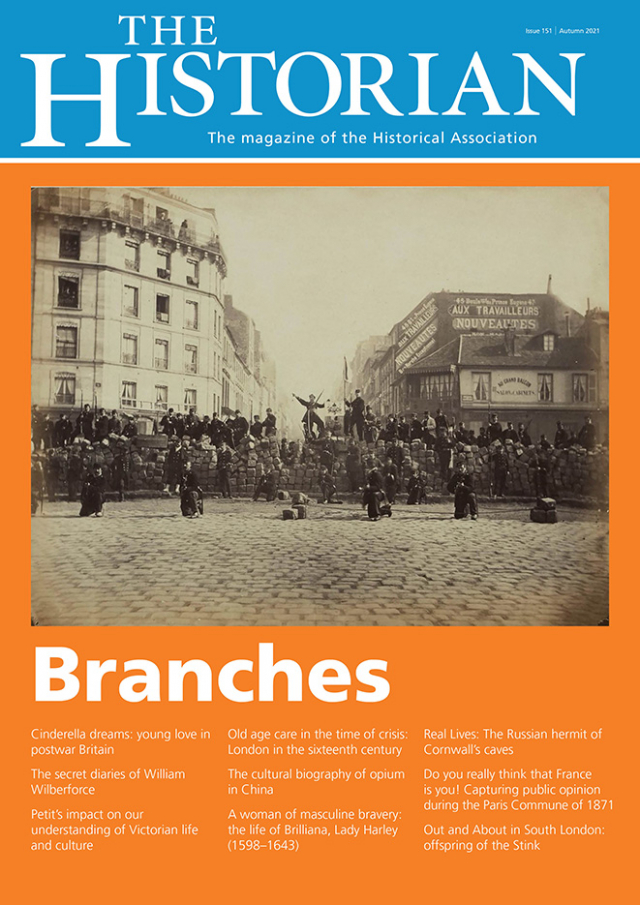The Historian 151: Out now
The magazine of the Historical Association

Editorial: Branches
Read The Historian 151: Branches
As life begins to return to some semblance of normality for many people, numerous HA branches are also resuming in-person meetings this autumn. Although online platforms such as Zoom offered branches the opportunity to continue running lectures and email allowed us to keep in touch with many of our members, there’s nothing quite like being able to talk to an enthusiastic expert over a cup of tea or coffee, or indeed, to catch up with friends and acquaintances face to face. Online meetings have also widened participation from some groups who would be unable to attend in person. On the other hand, we must never forget that not all our members are able to breach the digital divide, while others do not wish to engage with us in this way.
One thing that has been noticeable from my work on the Branches and Members Committee over the last 18 months has been the ways in which HA branches have shown that they are communities. Some phoned round their regular members to make sure that they were safe and well during the early days of the pandemic, others offered one-to-one ‘tutorials’ to ensure that their members were able to access Zoom meetings and take part in online events – and of course this assistance could then be put to use for other ends too. It’s been good to see how the branches have not just coped, but evolved, with some deciding to retain Zoom to allow them to hear lecturers from further afield, offer hybrid events or even to replace face-to-face lectures in the darkest, coldest winter months.
So after a difficult year for branches, this edition of The Historian has been a pleasure to put together. I really enjoy editing the Branches edition and I am happy to say that it is becoming something of a fixture in The Historian’s publication cycle. It’s great to be able to showcase some of the enlightening lectures, exciting activities and excellent speakers that the HA has to offer. This edition is no exception.
We open with articles based on two branch lectures. Carol Dyhouse gave her lecture on changing attitudes to marriage after the Second World War to the Cambridge Branch, highlighting the way in which popular culture contributed to teenage girls’ expectations and resulted in a drop in women’s average age at marriage. John Coffey’s talk on William Wilberforce’s diaries revealed to the Isle of Wight Branch just what can be learned by going back to the original documents rather than relying on the highly-selective edition published by his sons in 1838, five years after his death. Two more articles have links to our branch membership. Zheng Yangwen is a regular speaker to branches, and her fascinating article challenges familiar narratives about opium by reminding us that it was, at its heart, a consumer culture, however uncomfortable this might be to hear. Meanwhile, Christina Fox’s lecture on looking after the elderly poor in sixteenth-century London was one of the most popular contributions to the General Strand of the online HA Conference this year. Other articles widen our scope, but are again indicative of the wide range of activities you might find at your local branch. Sara Read’s article on Brilliana, Lady Harley, gives us an insight into how this young woman found fulfilment in family, education and standing up for her beliefs, while in the year of its 150th anniversary, Jason Jacques Willems explores the difficulties facing those who want to study popular opinion during the Paris Commune.
This year, we are pleased to be able to feature not one but two entries to the Young Historian competition. Tiffany Igharoro’s article on the artwork of the nineteenth-century architectural historian Revd John Louis Petit won the 2021 Young Historian Award for investigations into his life and work, while the unusual ‘Out and About’ feature by Flora Wilton Tregear won the Senior Prize for local history. She tells us about features of her local area which contributed to significant improvements in public health. Both authors should be congratulated on the maturity of their work, and we hope to hear more from them in the future.
Finally, Mike Short tells us about his favourite history place, Queen Square in Bath, which also happens to be the current home of the HA’s branch there, while James C. Pearce introduces us to the enigmatic ‘Lady Hermit of Cornwall’ in his Real Lives feature.
I hope that, like the branches themselves, this edition has something for everyone, and that you enjoy celebrating with us that, despite the upheavals since March 2020, branch activity continues to flourish.

